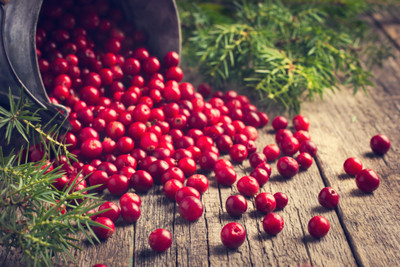The Health Benefits of Cranberries
Cranberries are a common side dish this time of year with 20% of all the cranberries grown consumed during Thanksgiving week alone. Rumored to have been served at the first Thanksgiving in 1621, cranberries have been known in the health and wellness industry for many years.
You can find cranberries in sauces, dried, blended with other fruits juices, and even in powdered form used in supplements. Because cranberries are extremely sour, they are very rarely eaten raw. Cranberries are 90% water, the remaining 10% is carbohydrates and fiber. Loaded with vitamins and minerals, especially vitamin C, cranberries are an excellent way to boost the nutrition to any dish.
Cranberries are an excellent source of antioxidants, which has been linked to improved urinary health and the prevention of urinary tract infections. There have been numerous studies indicating that drinking cranberry juice or taking cranberry supplements may reduce the risk of UTIs in both children and adults. It is important to point out that these studies support cranberries role in preventing infection, not treating an infection!
Cranberries have one of the highest amounts of antioxidant activity of any fruit or vegetable, falling just behind blueberries. The antioxidant proanthocyanidins (PAC) helps to prevent certain bacteria from sticking to the urinary tract wall. Cranberries are among the richest sources of proanthcyanidins and give cranberries their bright red color. This antioxidant has also been shown to possibly lower your risk of stomach cancer and ulcers by significantly reducing H. pylori from attaching to the lining of the stomach.
It is important to note that cranberry juice is usually sweetened with sugar or artificial sweeteners and has no health-promoting fiber. Look for juices that list cranberry juice as the primary ingredient for the most benefit, but aim for a 4 oz portion. Craisins, or dried cranberries, often have added sugars too. Remember to check the ingredient list for sugar, compare labels, and choose the product that is the lowest in sugar.
Ideas to increase your intake of cranberries are to add them to salads, cereal or oatmeal, mix into muffin batter or a smoothie, or add to a grain side dish. If you are on Coumadin or are prone to calcium oxalate-type kidney stones, you should talk with your physician before increasing the amount of cranberries in your diet.
While we say good bye to the fresh berries over the summer, we welcome the cranberry into our meals this fall and winter!

Interested in eating healthy? Hungry for more?







 Weight Loss
Weight Loss Health & Wellness
Health & Wellness Diabetes
Diabetes Heart Health
Heart Health Motherhood & Family
Motherhood & Family Dietary Restriction
Dietary Restriction Other Health Conditions
Other Health Conditions About SSHE
About SSHE


